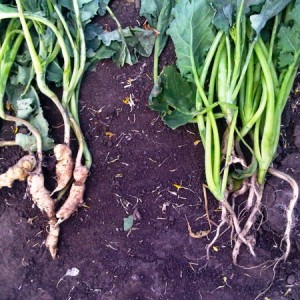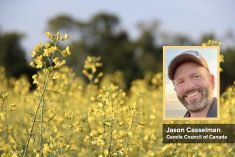As you drive throughout the region surrounding Edmonton, canola is inescapable. It’s absolutely everywhere. And looking at the crops, it’s easy to understand why. With long days, cool nights and adequate rainfall, this is canola country pure and simple, and in most seasons, the crop flourishes under nearly ideal conditions.
Canola has also been a crop — the only one over a long stretch from the early 1980s to early 2000s — that has reliably paid the bills. Small wonder then that farmers here and elsewhere have pushed their canola rotations as tightly as they have.
Read Also

Could crop sharing be a viable option for your farm?
Crop sharing could be a good option for young and beginning farmers.
Typical here is a two-year rotation that switches back and forth between canola and either wheat or perhaps another cereal. A few holdouts continue to grow peas, but larger farm sizes make that tough-to-harvest crop less attractive, and growing disease pressure has made peas less economic.
The two-year rotation, however, has contributed to the severity of clubroot, a pernicious soil-borne disease that’s now wreaking havoc among canola growers throughout the district.
Clubroot is a disease that’s never quite been seen in the same way anywhere else around the globe. And when it first appeared here, nobody could quite believe it.
- More Country Guide: The do’s and don’ts of clubroot
The root of the problem
Back in 2003, Dan Orchard was a young man, not many years out of university, working as an agronomist for a retail outlet in Sturgeon County, just north of Edmonton when he got a call from a grower who had an unexplained near-total failure of a canola crop. He asked Orchard to come see it.

After surveying the damage, Orchard pulled a few plants and was stunned by what he saw — malformed roots with enormous growths on them.
“It was absolutely incredible,” recalls Orchard, who now works as agronomist for the Canola Council of Canada. “There were growths the size of softballs and grapefruit on most of the roots, and some even larger, almost the size of footballs.”
Neither Orchard nor the affected farmer had ever before seen anything like it — but Orchard did have an inkling of what it might be. Due to what he himself calls “dumb luck,” he had happened to write a major paper in his final year at the University of Alberta’s agriculture program on canola diseases.
“I had needed to look at canola diseases, and I needed to discuss three,” Orchard explained. “The problem was, there really only were two — sclerotinia and blackleg. I picked a third one that had been a very minor problem, in other places, just to have a third disease. I picked clubroot.”
That fall in 2003, Orchard says he almost immediately began to suspect clubroot, and he even went so far as to call the province to tell them — but they weren’t convinced. They suggested he get a plant pathologist to look at it, causing Orchard to circle back to his alma mater, the U of A.
“I actually called my old plant pathology professor and asked him to look at it,” Orchard says. “He took one look at it and said it was clubroot, put in under the microscope and immediately confirmed it.”
After a somewhat frustrating runaround, suddenly the problem was now being taken as seriously as a heart attack. The next step was to show it to a pathologist, which was when the full gravity of the situation really hit home to Orchard.
“I showed it to him, and he wandered around the field like a zombie for almost 20 minutes, not saying anything,” Orchard says. “It was like he’d seen something from a horror movie, and that’s when I realized just how serious this must really be, when I saw how concerned these two plant pathologists were.”
At the end of the field inspection, the pathologist delivered a sobering assessment to Orchard:
“He told me that I now needed to decide if I was going to go public with this, or if I was going to shoot, shovel and shut up.” It was a phrase made famous by former Alberta premier Ralph Klein about his attitude to endangered wildlife legislation.
The ultimate decision was to go public, since the disease threatened far more than just a single canola crop in a single field; left unchecked, it could in fact threaten the entire canola industry in an affected area.
A few days later, at a press conference, the disease was revealed, and the modern era of clubroot control started for growers in the Edmonton area. It hasn’t always been a pleasant one. More than a little anger and animosity have spilled over, especially over issues like enforcing longer canola rotations on the hardest-hit fields. But it seems in hindsight that something had to be done. Left unchecked, biology would ultimately trump any hope of growing canola in tight rotations.
Uniquely Canadian
In most other regions of the world, clubroot is a minor annoyance. It does hit a handful of relatively high-value vegetable crops, but there are soil amendments that can knock it back. The trouble is, those treatments are expensive. They make sense if you’re grossing a few thousand dollars an acre with broccoli, but not a few hundred on canola.
In the few areas like the U.K., where the disease does exist and where they grow canola, farmers typically have many more cropping options that provide economic returns. In short, when the disease does pop up, the farmers have options.

Stephen Strelkov is a plant pathology professor at the University of Alberta, who had just joined the faculty less than two months before the first case of clubroot made headlines. He says like most Canadian plant pathologists, he had heard of clubroot and read about it in a textbook, but it was hardly something he was expecting to spend a large portion of his career on.
“It was the last thing in the world I ever expected to find myself working on,” Strelkov tells Country Guide. “But just a couple months after I started, the first sample of clubroot came in, and we had to get up to speed on it really quickly.”
Part of getting up to speed included making contact with people around the world who had already been looking at the disease. One of the first names he encountered was Geoff Dixon, a professor at the U.K.’s University of Reading. Strelkov sent him an email detailing the situation, only to receive a surprising response.
“He emailed me back and basically said, ‘I’ve been waiting a generation for your message,’” Strelkov says. “Apparently, back in the 1970s, people working on clubroot in Europe would get together and one of the questions they always asked was, ‘Why isn’t there clubroot in Canadian canola fields?’”
The answer starts with the unique biology of clubroot and its relationship to its host plants. Clubroot had long infected other crops — things like broccoli and cauliflower — that like canola are in the cole family. In fact, that may be how it came to be in the Edmonton region, carried along on saved seeds from these crops by immigrant farmers.
If so, it had hung out in soil at low levels, until something new came along in the 1970s — the canola industry. Suddenly there were susceptible crops everywhere, not just in little pockets like home and market gardens. But clubroot couldn’t run rampant just yet. It needed a few seasons to feel out this new potential host and find a way to tap into it — a process that’s known as developing affinity.
Whether this is how clubroot arrived, or if some other mechanism brought it here, the table was soon set for the disease’s inexorable march through the region.
Country Guide contacted Dixon, one of the acknowledged global experts on the disease, to talk about the Canadian situation. “You’re dealing with a global commodity crop with a huge financial value, and where there are industry bodies with real muscle,” Dixon says. “Stephen Strelkov and his colleagues have done a masterful job of identifying the size and scale of the problem and those approaches that are agronomically feasible and those which are not.”
All in all, he says, it’s turned Canada into the global leader on clubroot, Dixon says. The U of A’s Strelkov agrees, but adds it’s something everyone involved could do without.
“It’s a bit of a dubious distinction,” Strelkov says, “but I would say we’re at the forefront of this fight now.”
The response
Part of what’s made the fight against clubroot so difficult is the complex nature of the disease and the way it responds to traditional control strategies.
It can help to picture the situation as a GIS map. A company that wants to sell home alarm systems might start with a basic grid map, and then overlay data on household demographics, income and crime rates. By doing so, it could prioritize where to invest its marketing effort.
Now imagine a map of the Edmonton area overlaid with the biology of clubroot, the economics of agriculture, and local politics. Suddenly, it doesn’t seem so simple.
Begin by getting a clear picture of the scope of the problem. Strelkov says the spore count in the soils is the key. A canola crop can probably survive and do well if the spore levels are kept low — a few thousand per gram, say. But the disease can ramp up quickly with tight canola rotations, and measurements in the hundreds of thousands and even over a million spores per gram aren’t uncommon in the most heavily infested fields, Strelkov says.
“Say you have a half-million spores per gram, and you need to get it down to a few thousand per gram to produce canola economically,” Strelkov says. “Now realize that the half-life of these spores is about four years. So in four years you’re down to 250,000 spores, in eight years 125,000, in 12 years 62,500… a serious infestation can easily take a field out of canola production for 20 years, assuming no resistant varieties.”
It raises the question: is clubroot a potential canola killer?
“Yes, absolutely,” Strelkov says. “Especially if there are no resistant varieties, or if the resistance breaks down quickly, which we’re already seeing some evidence is the case.”
He’s referring to the introduction of the first clubroot varieties in 2009. Just a few seasons later, there already seems to be some evidence the disease populations have shifted and new strains are sidestepping that resistance. Geoff Dixon says he’s unsurprised by the news, saying it’s pretty typical of what they’ve seen elsewhere.
“The pathogen is very capable of evolving in order to circumvent resistance,” Dixon says. “It’s the classic ‘boom and bust’ seen many times in other pathogens.”
To understand why resistance breaks down so quickly, researchers think about it in similar terms to how weeds develop chemical resistance. In that case, the repeated application of a herbicide over many years “selects” for the very few individuals which have natural resistance to the chemical. All the vulnerable individuals die off, leaving only the resistant plants to breed, resulting in a turnover of the weed population and what seems like the sudden emergence of a full-blown resistance problem.
In the clubroot scenario, growers with heavy disease pressure have little choice but to plant resistant canola, yet the sheer number of spores can quickly overwhelm the resistance through the same mechanism of selecting the small handful that can survive. After four or five seasons or so, their numbers creep high enough to hurt the crop’s yield.
“Selection pressure is always a numbers game, and we’re dealing with big numbers here,” Strelkov says.
In 2007, the Alberta provincial government declared clubroot a pest under the Agricultural Pests Act, giving legal teeth to efforts to contain the problem, and bring- ing politics and economics into the equation. (Saskatchewan followed in 2009.)
Inevitably this also kicked off some serious controversy, since one of the tools for reining in clubroot calls for enforcing four-year or even longer canola rotations in the hardest-hit fields. Telling their neighbours what they can and cannot grow isn’t the kind of job most rural politicians thought they signed up for.
It also led to surprising divergences in response throughout the area because of a quirk in how local affairs are ordered. In Alberta, a lot of responsibility for pest issues falls to the local counties through their agricultural fieldmen, who take direction from the local government.
“Some counties took it very seriously, right from the start, coming up with a plan and periodically revisiting it,” says Dan Orchard. “Others thought farmers should be left to manage it themselves and basically had no policy. Another group set policies, then never revisited them as the situation evolved.”
It made for a patchwork of solutions with varying degrees of success, from draconian policies that alienated growers, to a laissez-faire free-for-all, and everything in between. If one thing has become apparent in the Alberta experience, however, it’s that good policies count for something.
Getting it right
Again and again during Country Guide’s visit to the affected area, a variation of the same theme came up: “Want to see clubroot control in action? Visit Leduc County, because they’re getting it right.”
We caught up to agricultural fieldman Aaron VanBeers one morning at his office in the agricultural services building of the Leduc County Centre. It was a bright sunny day, the canola was all entering full bloom, and the crops were looking great — all this despite being at the very epicentre of the clubroot zone, one of three counties that show up on the Alberta government’s clubroot map in bright red, indicating the heaviest infestations.
We begin a wide-ranging discussion about what’s worked in the county, and VanBeers says it all boils down to taking clubroot seriously, getting on it right away, working closely with local farmers, avoiding alienating them, and being willing to revisit and redesign policies as the need and ability arise.
“My predecessor, who was also a farmer, realized right away how serious this was,” VanBeers says. “The local government and the agricultural services board also understood quite early what we were facing.”
They surveyed all the canola fields in the county — a practice that continues today — to deter- mine the scale of the problem. They imposed longer rotations on the hardest-hit fields, after very carefully communicating to growers why this was necessary. And when more information about the disease became available, and the first resistant varieties appeared, they relaxed rotation restrictions on lower-risk fields.
What VanBeers describes is good old-fashioned political leadership. A difficult situation was faced up to square on. Policies based on facts were developed, then periodically re-evaluated as new facts emerge and the understanding of the situation evolves over time. And as a result, while nobody likes the situation, everyone more or less continues to work together to keep the problem under control.
“I think most farmers in the county understand what we’re doing, why we’re doing it, and they support it,” VanBeers said. “Of course there’s always that two per cent — actually it’s probably even quite a bit lower than that — that you’ll never get through to, that think they should just be allowed to do whatever they do, without considering the impact it has.”
Essentially the approach in Leduc County is much like one that public health officials would use when dealing with a communicable disease, with steps being taken to limit the ability of infected individuals to spread it to new victims. But of course, there’s another dynamic at play too, of shame and secrecy. A growing number of farmers don’t want to talk about the disease, or let anyone know it’s on their land.
In no small part that’s because frequently the disease has been portrayed as something that’s linked to bad farming practices, ignoring the economic necessity that farmers in the region have laboured under for decades.
The situation is going to continue to evolve, but one thing is beginning to appear quite clear — it’s likely to become an issue for more growers in more areas as time rolls on. Orchard says there’s a wealth of information to be found from what’s happened in Alberta.
“I do think that other places that are starting to grapple with this problem can learn from what we did right and the things that didn’t work out as well,” Orchard says (see sidebar).
One thing Orchard is firm about is the necessity to face up to the disease and deal with it head on, drawing the familiar analogy to a serious health challenge. Like many human diseases, early diagnosis almost always equals a better prognosis, as a doctor would say.
“If you catch it early, if you catch it when the spore level isn’t too high, it’s always going to be easier to deal with,” Orchard says.
And while some say Orchard deserves credit for spotting the disease, he quickly downplays his own role, saying any competent agronomist would have figured it out fairly quickly, if they’d seen that first field.
“I guess finding it is my claim to fame in the agriculture industry in Western Canada,” Orchard says. “But really, it’s not something I’m proud of. I should have found it 10 years earlier, before it was such a big problem, but it just wasn’t the practice at the time to go out and pull plants from small dead patches in the field at harvest time.”


















